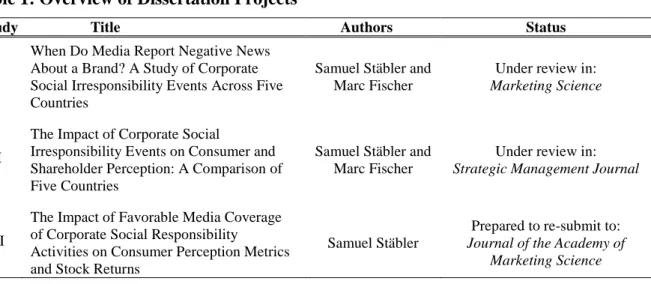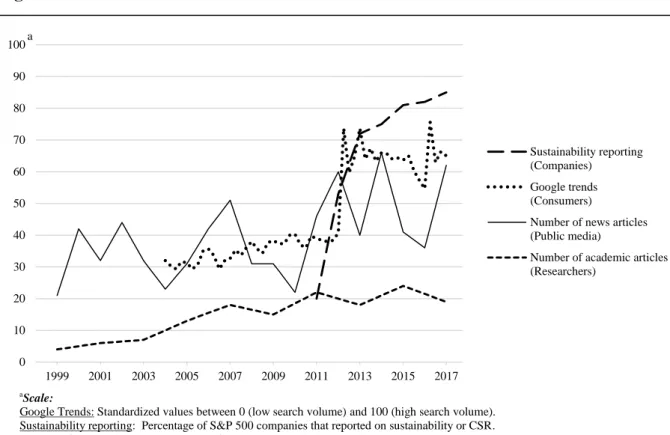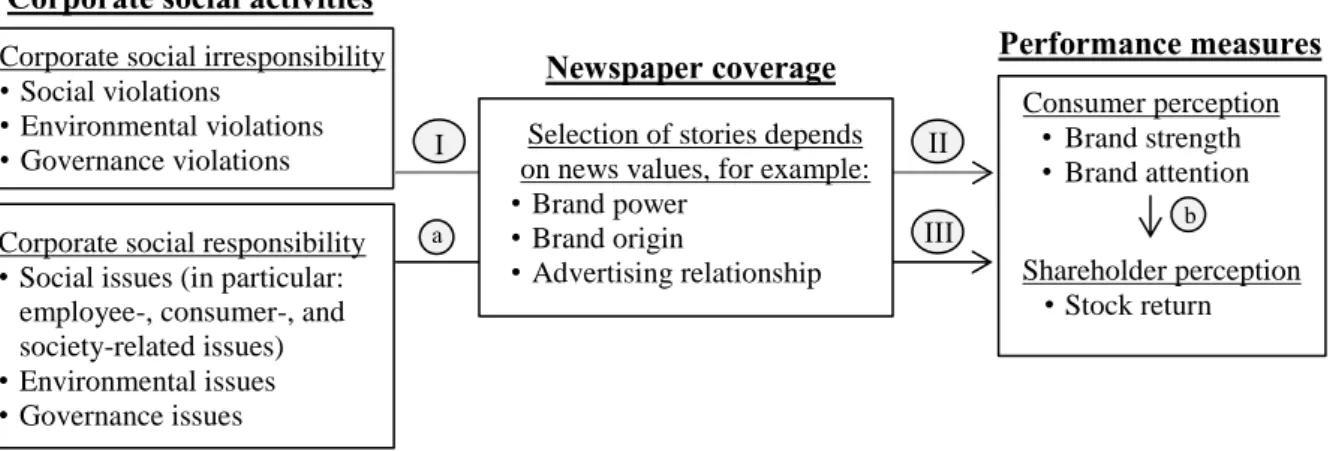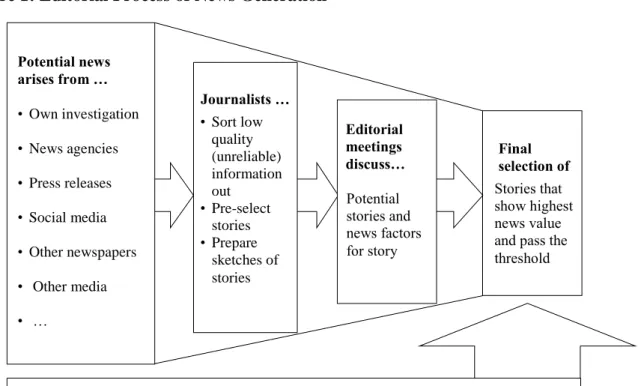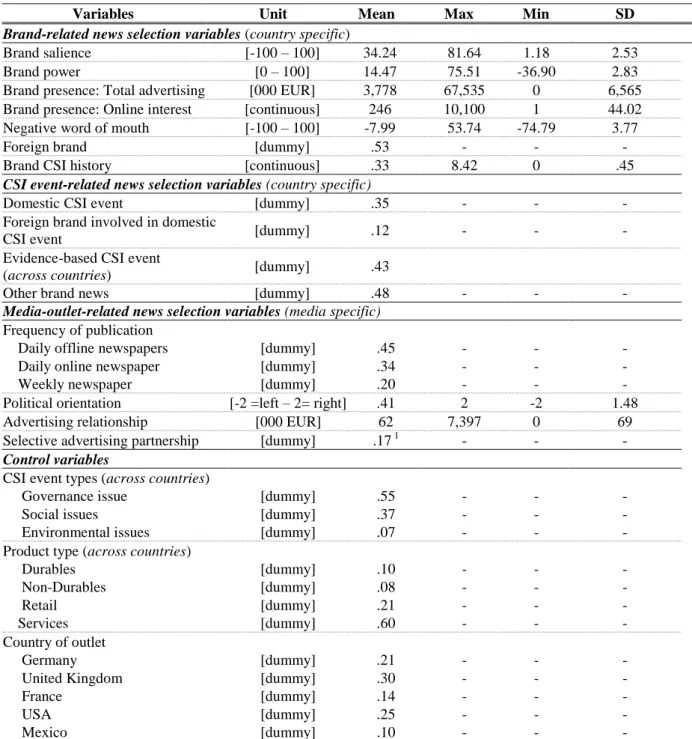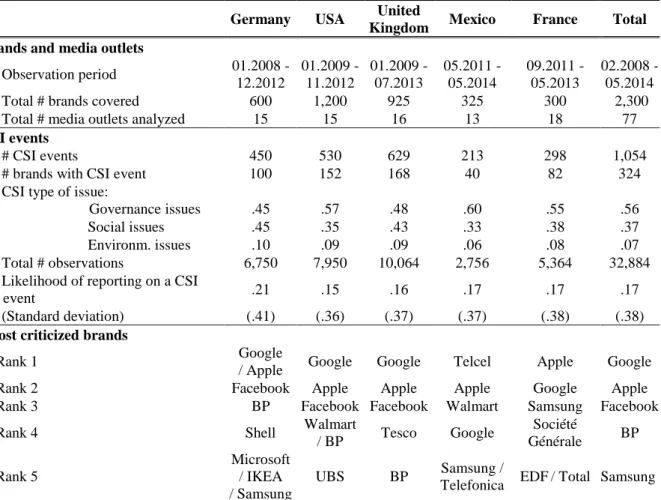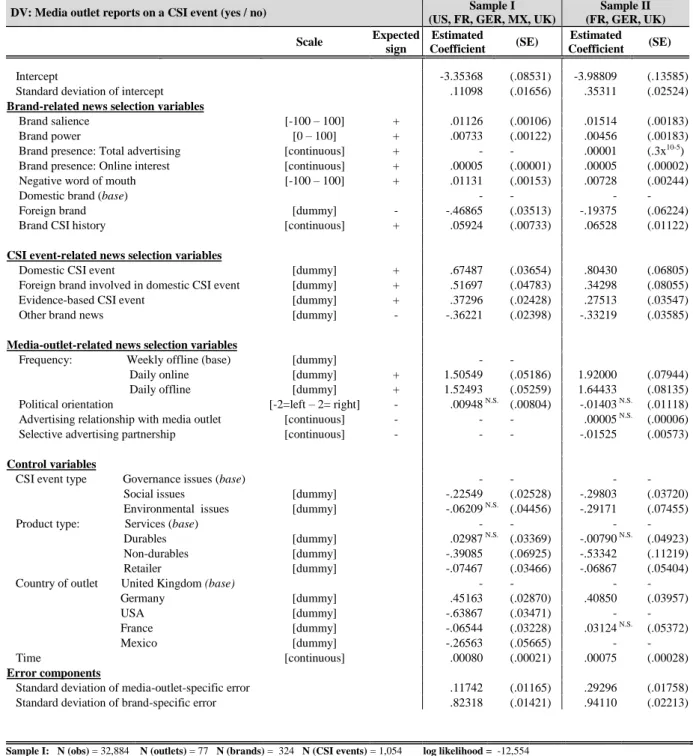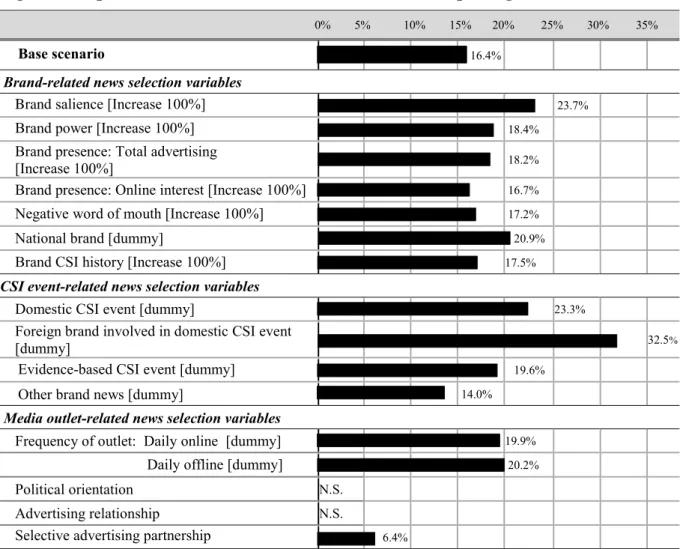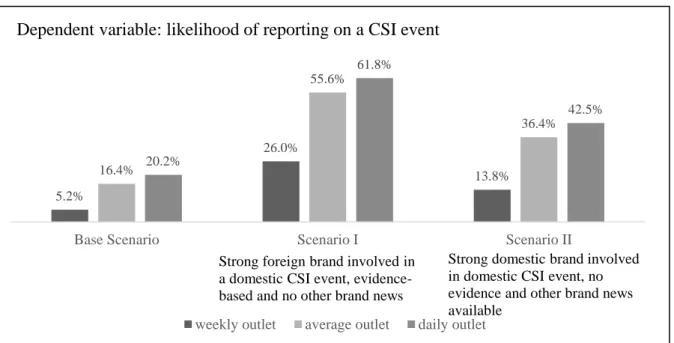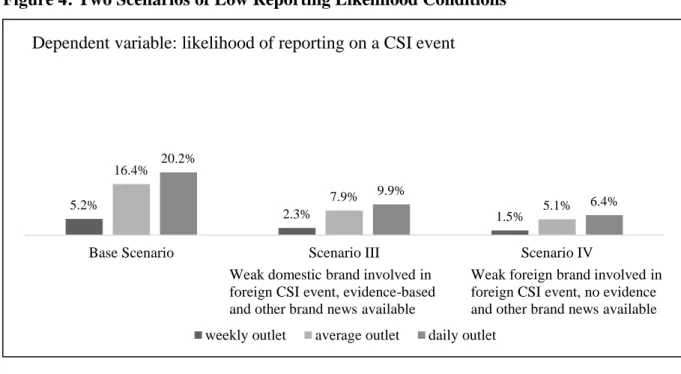THREE ESSAYS ON THE POSITIVE AND NEGATIVE CONSEQUENCES OF CORPORATE SOCIAL RESPONSIBILITY
AND IRRESPONSIBILITY
Inauguraldissertation zur
Erlangung des Doktorgrades
der Wirtschafts- und Sozialwissenschaftlichen Fakultät der Universität zu Köln
2018
vorgelegt von M.Sc. Samuel Stäbler
aus
Karlsruhe
Referent: Prof. Dr. Marc Fischer
Korreferent: Prof. Dr. Werner Reinartz
Tag der Promotion: 24. Oktober 2018
Acknowledgements
This thesis is the culmination of my journey as a doctoral student. It is comparable to climbing a high peak—step by step—exciting, encouraging, breathtaking and frustrating at the same time.
The feeling of strength and fulfillment at the top, accomplishing the final work, is something that can hardly be put into words. Though, I would like to express my appreciations to the people that accompanied me on this journey and significantly contributed to this final work.
I would like to sincerely thank my supervisor Professor Fischer for his support, guidance, and his confidence in me throughout the last five years. I highly value his personal and his academic support, advices, and useful critiques. I am happy and grateful that he made me become a “real”
researcher. I am looking forward to have tons of further research discussions and projects with him in future. Also, I would like to express my very great appreciations to Prof. Reinartz for serving as a member and Prof. Bruno for being the head of my dissertation committee.
Furthermore, I would like to thank Prof. van Heerde who welcomed me as visiting researcher at Massey Univesity in New Zeland. I am grateful for his valuable advices throughout and above my stay.
I would not have been able to complete this dissertation without the help of colleagues who have offered guidance, tons of feedback, suggestions and fun (including one or two Kölsch) along the tough way—I am incredibly happy to have made a lot new friends: Thank you! My earnest thanks to Christa Körner— the front office manager and heart of our chair. She has always been there for me providing personal, emotional, and professional guidance. I am very glad to have made her a good friend. Also, I am grateful for the assistance given by student assistants. I challenged them, gave them tons of exhausting work and I do appreciate every task they have accomplished for me.
To all of my friends, thank you for understanding and encouraging me in times when the doctoral thesis challenged my limits. We participated in so many events together (e.g., skiing, scuba diving, party weekends...) that generated the necessary energy to be working efficiently on my thesis.
No business is like family business: I would like to express my sincere appreciations to my brothers Jonathan, Dominik (& Nui), and Thomas (& Sisi, Lara, and Valentin). Thousand times they proofread my papers, listened to me practicing my presentations and discussed new research ideas with me: Thank you! I would also thank my godchild Emma Poltz who was just born when I started my doctoral thesis. She has always allowed me to enter a world of being childish and silly.
She gave me the chance to forget everything around me. Thank you! Further, I am grateful for the wisdom of my grandparents—Anna and Tibor Farkas-Jandl, and Emma Stäbler who have always believed in me and supported me whatever I have done.
Last and most important, this dissertation is dedicated to my parents Bernadette and Dieter Stäbler: You supported me my whole life and were always there for me. I am immeasurably grateful for your wisdom, encouragement, and your endless love. Without you I would have never been who I am today. Thank you both for giving me the strength and happiness to reach my dreams.
Samuel Stäbler
C
ONTENTSL
IST OFF
IGURES... V L
IST OFT
ABLES... VI L
IST OFA
BBREVIATIONS... VII
S
YNOPSIS... 1
1 Short Overview ... 1
2 Introduction ... 2
2.1 Relevance ... 2
2.2 Literature Gaps ... 4
2.3 Research Focuses and Contributions ... 6
2.4 Overall Results ... 9
3 Summary of Dissertation Projects ... 11
3.1 Paper I: When Do Media Report Negative News About a Brand: A Study of Corporate Social Irresponsibility Events Across Five Countries ... 11
3.2 Paper II: The Impact of Corporate Social Irresponsibility Events on Consumer and Shareholder Perception: A Comparison of Five Countries ... 13
3.3 Paper III: The Impact of Favorable Media Coverage of Corporate Social Responsibility Activities on Consumer Perception Metrics and Stock Returns .. 15
R
EFERENCESS
YNOPSIS... 18
P
APERI: W
HEND
OM
EDIAR
EPORTN
EGATIVEN
EWSA
BOUT AB
RAND? A S
TUDY OFC
ORPORATES
OCIALI
RRESPONSIBILITYE
VENTSA
CROSSF
IVEC
OUNTRIES... 21
A
BSTRACT... 21
1 Introduction ... 22
1.1 Research Question and Contribution ... 23
1.2 Related Literature ... 24
2 A Model of Negative Corporate News Selection ... 26
2.1 Theory of News Value ... 26
2.2 Deriving News Selection Criteria ... 27
2.3 Model ... 29
3 News Selection Variables for Corporate Social Irresponsibility Events ... 30
3.1 Brand-related News Selection Variables ... 32
3.2 CSI Event-related News Selection Variables ... 34
3.3 Media-outlet-related News Selection Variables ... 36
4 Data and Methodology ... 37
4.1 Sampling and Search Strategy... 37
4.2 Variable Operationalization ... 40
4.3 Summary Statistics and Model-free Evidence ... 42
4.4 Econometric Model Specification ... 43
4.5 Identification and Endogeneity ... 44
5 Results ... 46
5.1 Hypotheses on Brand-related News Selection Variables ... 47
5.2 Hypotheses on CSI Event-related News Selection Variables ... 48
5.5 Robustness Checks ... 49
6 Discussion and Conclusions ... 50
6.1 Magnitude of the Influence of News Selection Variables ... 50
6.2 Implications for Marketing Theory ... 54
6.3 Implications for Firms, Society, and Media ... 55
6.4 Limitations and Future Research ... 57
R
EFERENCESP
APERI ... 58
A
PPENDIXP
APERI ... 61
Appendix 1 Media Outlets Used in the Empirical Study ... 62
Appendix 2 Search Strategy for Identifying CSI Events ... 63
Appendix 3 Diffusion of Media Reports ... 64
Appendix 4 Operationalization and Correlation of Variables ... 65
Appendix 5 Information on YouGov Methodology ... 68
Appendix 6 Model-free Evidence ... 70
Appendix 7 Exogeneity Tests and IV Estimation ... 71
Appendix 8 Estimation Results for Model by Country ... 74
Appendix 9 Robustness Checks ... 75
R
EFERENCESA
PPENDIXP
APERI ... 80
P
APERII: T
HEI
MPACT OFC
ORPORATES
OCIALI
RRESPONSIBILITYE
VENTS ONC
ONSUMER ANDS
HAREHOLDERP
ERCEPTION: A C
OMPARISON OFF
IVEC
OUNTRIES... 81
A
BSTRACT... 81
1 Introduction ... 82
2 Related Literature ... 85
3 Conceptual Foundation of a Cross-cultural Model ... 87
3.1 Theory of Cultural Values ... 87
3.2 Elements of the Conceptual Model ... 87
4 Expectations of the Consequences of CSI ... 90
4.1 Impact of CSI Events on Consumer Perception ... 90
4.2 Impact of CSI Events on Shareholder Perception ... 93
5 Data and Methodology ... 95
5.1 Database ... 95
5.2 Event Study Methodology ... 97
5.3 Cross-sectional Regressions ... 99
5.4 Operationalization of the Independent Variables ... 100
5.5 Identification Strategy and Simultaneity Issues ... 102
6 Results ... 103
6.1 Model-free Evidence ... 103
6.2 Estimation Results ... 105
6.3 Robustness Checks ... 111
7 Discussion ... 112
7.1 Summary ... 112
7.2 Financial Magnitude ... 114
7.3 Managerial Implications ... 115
7.4 Implications for Theory ... 115
7.5 Limitations and Further Research ... 116
R
EFERENCESP
APERII ... 117
A
PPENDIXP
APERII ... 122
Appendix 1 Literature Overview on the Impact of CSI on Stock Return ... 123
Appendix 2 Overview of Media Outlets ... 124
Appendix 3 Criteria to Identify CSI Events ... 125
Appendix 4 Classification of Confounding Events ... 126
Appendix 5 Details on Consumer Perception Data ... 127
Appendix 6 External Validity of Brands in Dataset ... 129
Appendix 7 Endogeneity Issues ... 130
Appendix 8 Main Effect Analysis ... 133
Appendix 9 Three-step Mediation Approach ... 134
Appendix 10 Various Robustness Checks ... 135
R
EFERENCESA
PPENDIXP
APERII ... 145
P
APERIII: T
HEI
MPACT OFF
AVORABLEM
EDIAC
OVERAGE OFC
ORPORATES
OCIALR
ESPONSIBILITYA
CTIVITIES ONC
ONSUMERP
ERCEPTIONM
ETRICS ANDS
TOCKR
ETURNS... 148
A
BSTRACT... 148
1 Introduction ... 149
2 Related Literature ... 153
3 Conceptual Framework ... 157
3.1 Underlying Theories ... 157
3.2 Conceptual Model ... 158
3.3 Expectations Regarding the Effect on Consumer Brand Perception ... 160
3.4 Expectations Regarding the Effect on Stock Returns ... 163
4 Database ... 164
4.1 Consumer Brand Perception Data ... 164
4.2 Stock Return Data ... 165
4.3 Favorable Media Coverage of CSR Activities ... 165
4.4 Variable Operationalization and Descriptive Statistics ... 166
5 Methodology ... 168
5.1 Impact of CSR Activities on Consumer Brand Perception ... 168
5.2 Moderating Analysis Concerning Consumer Brand Perception ... 169
5.3 Impact of CSR Activities on Stock Returns ... 170
5.4 Relationship of Consumer Brand Perception Changes and Stock Returns ... 171
5.5 Identification Strategy and Sampling Issues ... 171
6 Results ... 172
6.1 Model-free Evidence ... 172
6.2 Main Impact on Consumer Brand Perception and Stock Returns ... 175
6.3 Conditions that Drive Consumer Brand Perception ... 176
6.4 Relationship of Brand Perception Changes and Stock Returns ... 178
6.5 Robustness Checks ... 179
7 Discussion ... 180
7.1 Conclusions ... 180
7.2 Managerial Implications ... 182
7.3 Limitations and Avenues for Further Research ... 183
R
EFERENCESP
APERIII ... 184
Appendix 2 Keywords Used to Identify Relevant CSR Activities ... 192
Appendix 3 Overview of the Identified CSR Activities ... 193
Appendix 4 Models Controlling for Brand-specific Heterogeneity ... 195
Appendix 5 Sample Selection Issues ... 196
Appendix 6 Various Robustness Checks ... 197
Appendix 7 Model Including Brand-specific Fixed Effects ... 198
R
EFERENCESA
PPENDIXP
APERIII ... 199
E
IDESSTATTLICHEE
RKLÄRUNG... VIII
C
URRICULUMV
ITAE... IX
L
IST OFF
IGURESS
YNOPSISFigure 1: Evolution of Attention to CSR ... 2
Figure 2: Framework on the Potential Consequences of Corporate Social Activities ... 6
P
APERI: W
HEND
OM
EDIAR
EPORTN
EGATIVEN
EWSA
BOUT AB
RAND?
A S
TUDY OFC
ORPORATES
OCIALI
RRESPONSIBILITYE
VENTSA
CROSSF
IVEC
OUNTRIESFigure 1: Editorial Process of News Generation ... 28
Figure 2: Impact of Selection Variables on Likelihood of Reporting on a CSI Event ... 51
Figure 3: Two Scenarios of High Reporting Likelihood Conditions ... 52
Figure 4: Two Scenarios of Low Reporting Likelihood Conditions ... 53
P
APERII: T
HEI
MPACT OFC
ORPORATES
OCIALI
RRESPONSIBILITYE
VENTS ONC
ONSUMER ANDS
HAREHOLDERP
RECEPTION:
AC
OMPARISON OFF
IVEC
OUNTRIESFigure 1: Conceptual Model ... 88
Figure 2: Financial Magnitude: Simulation of Effect Strengths ... 114
P
APERIII: T
HEI
MPACT OFF
AVORABLEM
EDIAC
OVERAGE OFC
ORPORATES
OCIALR
ESPONSIBILITYA
CTIVITIES ONC
ONSUMERP
ERCEPTIONM
ETRICS ANDS
TOCKR
ETURNSFigure 1: Conceptual Framework ... 159
Figure 2: CSR Impact on BrandIndex by Examples ... 173
L
IST OFT
ABLESS
YNOPSISTable 1: Overview of Dissertation Projects ... 1
P
APERI: W
HEND
OM
EDIAR
EPORTN
EGATIVEN
EWSA
BOUT AB
RAND?
A S
TUDY OFC
ORPORATES
OCIALI
RRESPONSIBILITYE
VENTSA
CROSSF
IVEC
OUNTRIESTable 1: News Selection Variables for CSI Events and Their Correspondence to Original News Factors ... 31
Table 2: Summary Statistics of News Selection Variables ... 40
Table 3: Summary Statistics for CSI Events by Country ... 42
Table 4: Estimation Results for Model (5) ... 47
P
APERII: T
HEI
MPACT OFC
ORPORATES
OCIALI
RRESPONSIBILITYE
VENTS ONC
ONSUMER ANDS
HAREHOLDERP
RECEPTION:
AC
OMPARISON OFF
IVEC
OUNTRIESTable 1: Expectations Regarding the Effect of CSI on Perception Metrics ... 91
Table 2: Sample and Descriptives ... 96
Table 3: Measurement of the Variables and Summary Statistics ... 101
Table 4: Model-free Evidence ... 104
Table 5: Main Impact of CSI on Perception Metrics: Estimation Results ... 106
Table 6: Cross-sectional Regressions: Drivers of Brand Strength ... 108
Table 7: Cross-sectional Regressions: Drivers of Brand Attention ... 109
Table 8: Cross-sectional Regressions: Drivers of Stock Return ... 110
P
APERIII: T
HEI
MPACT OFF
AVORABLEM
EDIAC
OVERAGE OFC
ORPORATES
OCIALR
ESPONSIBILITYA
CTIVITIES ONC
ONSUMERP
ERCEPTIONM
ETRICS ANDS
TOCKR
ETURNSTable 1: Representative Research on CSR Effects ... 153
Table 2: Summary Descriptives ... 167
Table 3: Model-free Evidence ... 174
Table 4: Main Impact of CSR Activities on Brand Perception Metrics ... 175
Table 5: Main Impact of CSR Activities Impact on Stock Returns ... 175
Table 6: Drivers of Brand Perception Metrics ... 177
Table 7: Drivers of Stock Return ... 179
L
IST OFA
BBREVIATIONSAAR Average abnormal returns
ANOVA Analysis of variance
AR Abnormal returns
BI BrandIndex
CAAR Cumulative average abnormal returns CAR Cumulative abnormal returns
CSI Corporate social irresponsibility CSR Corporate social responsibility d.f. Degrees of freedom
DV Dependent variable
FR France
GER Germany
IV Instrumental-variable
LL Log likelihood
MX Mexico
N Sample size
N.S. Not significant N/A Not available N/E No expectations OLS Ordinary least squares SD Standard deviation
SE Standard error
UK United Kingdom
US United States of America WOM Word-of-mouth
WVS World value survey
2SLS Two-stage least square
S
YNOPSIS1 Short Overview
The objective of this cumulative dissertation is to derive new insights into the positive and negative consequences of Corporate Social Responsibility (CSR) and Corporate Social Irresponsibility (CSI). Table 1 gives an overview about the dissertation projects including titles, authors, and publication statuses.
As public media coverage is a crucial driver of the consequences of CSI (e.g., Liu and Shankar 2015), the first essay of this dissertation investigates how offline and online newspapers select specific CSI events among others. Researchers have so far not investigated media selection biases of CSI. The second essay analyzes country-specific differences of the impact of CSI events on consumer perception metrics and stock return. Even though the literature shows a negative effect on consumer perceptions (e.g., Ahluwalia, Burnkrant, and Unnava 2000), authors have mostly neglected to analyze cross-cultural differences.
Furthermore, the second essay identifies how consumer responses to CSI influence the stock return of a company. The third essay analyzes how CSR activities impact consumer perception metrics and stock return. The focus here is the critical role of public media coverage, diverse effects of different CSR types, and the relationship between consumer responses and stock return.
Table 1: Overview of Dissertation Projects
Study Title Authors Status
I
When Do Media Report Negative News About a Brand? A Study of Corporate Social Irresponsibility Events Across Five Countries
Samuel Stäbler and Marc Fischer
Under review in:
Marketing Science
II
The Impact of Corporate Social
Irresponsibility Events on Consumer and Shareholder Perception: A Comparison of Five Countries
Samuel Stäbler and Marc Fischer
Under review in:
Strategic Management Journal
III
The Impact of Favorable Media Coverage of Corporate Social Responsibility
Activities on Consumer Perception Metrics and Stock Returns
Samuel Stäbler
Prepared to re-submit to:
Journal of the Academy of Marketing Science
2 Introduction 2.1 Relevance
CSR—company actions that maximize the positive impact and minimize the negative impact on society and thereby go beyond what is required by law (Pride and Ferrell 1995, McWilliams and Siegel 2001)—has received increasing attention over the last years, both from practitioners and researchers (Flammer 2013). CSR is thereby not limited to “social”
responsibility (e.g., paying fair wages), but also includes environmental (e.g., improving CO2 conditions) and governance (e.g., board gender diversity) issues. Figure 1 demonstrates the increasing relevance of CSR-related topics for companies, consumers, public media, and research over time.
Figure 1: Evolution of Attention to CSR
aScale:
Google Trends: Standardized values between 0 (low search volume) and 100 (high search volume).
Sustainability reporting: Percentage of S&P 500 companies that reported on sustainability or CSR.
Number of news articles: Total number of news articles in the New York Times, Wall Street Journal and USA Today.
Number of academic articles: Total number of articles published in the premier (i.e., A-level) marketing journals (see VHB 2018).
Note: For some trend curves, data is only publicly available for a specific time frame (e.g., Google Trends data starts in 2004).
First, corporate reporting on sustainability rose dramatically from 2011, when roughly 20% of the S&P 500 companies published such reports, up to 85% in 2017 (Governance and
0 10 20 30 40 50 60 70 80 90 100
1999 2001 2003 2005 2007 2009 2011 2013 2015 2017
Sustainability reporting (Companies)
Google trends (Consumers)
Number of news articles (Public media)
Number of academic articles (Researchers)
a
activities in order to help alleviate the grievances in the world and thereby benefit from positive consumer responses and build up a company’s reputation (Hildebrand et al. 2017).
Second, Google Trends demonstrate that the demand for topics related to CSR on Google’s search engine almost doubled in the last ten years. Undoubtedly, many consumers demand ethical correctness: For example, consumers increasingly invest in socially responsible funds, consume fair-traded products, or buy environment-friendly products (Bhattacharya and Sen 2004). Third, companies’ social performance has also come under increasing surveillance by public media. A search was conducted for the number of unique newspaper articles in the New York Times, Wall Street Journal, and USA Today that referred to the term CSR. While the number of articles was 21 in 1999, it rose to 62 in 2017. Fourth, the number of academic articles in premier marketing journals
1that contain the keyword CSR almost doubled in the last 20 years: 98 articles were published in the last ten years (2008-2017), whereas ten years before (1999-2007) 51 articles were published.
An additional statistical analysis underlines the raising demand from companies and society for topics relating to CSR over time: A calendar time variable (i.e., yearly quarters) is statistically significant for all trend curves (p < .01)
2. Furthermore, the high correlations of these trend curves (e.g., up to r = .78, p < .01) indicate strong independencies of companies, consumers, public media, and research in the demands for CSR.
The high importance of CSR for these interest groups also brings along that CSI—
company actions that go against moral norms including environmental, governance, or social violations (e.g., Backhaus and Fischer 2016; Lange and Washburn 2012)—receives higher attention than ever before. In fact, events of CSI are published in the newspapers all over the world. Examples include the oil spill of BP in the Gulf of Mexico (NYT 2010), child labor issues at Asos factories in Turkey (BBC 2016), as well as the pollution scandal of
1 This analysis refers to the marketing journals that are ranked as an A-level journal according to VHB (2018).
2 Regressing each index (e.g., Google Trends) on a time variable (i.e., yearly quarters) shows significant effects of the time variable (i.e., t-value at least t = 5.37).
Volkswagen (CNN 2015). Therefore, investors seem to no longer tolerate unethical corporate behavior. For example, as a result of the pollution scandal, the Volkswagen share price dropped dramatically by 22% over night (Siano et al. 2017). Furthermore, consumers boycott unethical corporate behavior. A prominent example that resulted in a consumer boycott is the online firestorm against Nestlé in 2010 (Lamb, Hair, and McDaniel 2013). Environmentalists accused Nestlé for its massive use of palm oil destroying rainforests and thus the habitat of the orangutans. These negative online firestorms also induced classical news media to report on this case (e.g., CNN 2010).
How companies can protect themselves from negative media coverage, consumer responses, and investor reactions to CSI is a central research topic of this dissertation.
Furthermore, this dissertation elaborates how companies can use CSR as an appropriate tool to increase the potential benefits. Each of the dissertation’s essays identifies and closes a research gap that is highly relevant for companies, consumers and the society as a whole. The next section will briefly highlight the identified research gaps. Each essay of this dissertation, however, provides a detailed literature review in the essays themselves.
2.2 Literature Gaps
In line with the increasing practical relevance of CSR for society, there is a growing academic interest in the consequences of CSR and CSI. Whereas most empirical studies focus on the positive consequences of CSR (e.g., Hawn, Chatterji, and Mitchell 2018; Hildebrand et al. 2017; McWilliams and Siegel 2000), the negative effects of CSI have been less studied (e.g., Groening and Kanuri 2013). Despite the large number of articles available in this field, this dissertation identifies several research gaps:
First, even though media coverage has been identified as a central driver that shapes the
depth and length of the consequences of CSI (e.g., Backhaus and Fischer 2016; Kölbel,
news. Even though there is an important stream of theoretical research in marketing and economics that studies media biases in a game-theoretic environment (e.g., Gal-Or, Geylani, and Yildirim 2012; Yildirim, Gal-Or, and Geylani 2013; Xiang and Sarvary 2007; Zhu and Dukes 2015), empirical insights into the existence of these selection biases of CSI do not exist. By investigating how newspapers select CSI events, this dissertation extends the marketing literature on brand / firm crises in a new direction.
Second, the literature suggests a negative effect of CSI on consumer perception measures (e.g., Ahluwalia, Burnkrant, and Unnava 2000; Pullig, Netemeyer, and Biswas 2006; Roehm and Tybout 2006; Dutta and Pullig 2011). However, cross-cultural differences have been ignored so far (Cleeren, Dekimpe, and van Heerde 2017). Given the international scope of corporate activities, this is surprising. By identifying how CSI events are perceived differently across countries, this dissertation extends the current literature on CSI to an international context.
Third, even though the current literature indeed shows that CSR activities have a positive impact on consumer perceptions measures (e.g., Brown and Dacin 1997; Hildebrand et al.
2017; Sen and Bhattacharya 2001), none of these studies focused on how CSR activities and which CSR types should be published in public media to derive a positive effect. This omission is critical as public media reporting has an extreme power on what consumers think about a company and its brands (Ahluwalia, Burnkrant, and Unnava 2000). By combining the impact of observed CSR activities in public media and daily-observed consumer perception metrics, this dissertation extends prior research.
Fourth, even though many studies investigated the impact of CSI events on stock returns (e.g., Flammer 2013; Groening and Kanuri 2013), the findings have been contradicting.
Similarly, the effect of CSR activities on stock returns is ambiguous (e.g., Wright et al. 1995;
Groening and Kanuri 2013). Why these conflicting differences occur across these studies is a
challenging question. One reason may lie in the fact that barely any study investigates how the consumer response to corporate social activities may determine the effect on stock return.
This neglect is a substantial deficit, as the efficient market hypothesis (Fama et al. 1969) suggests that investors make decisions based on expected future cash flows which are influenced by consumer responses. Thus, this dissertation gives insights into how consumer responses determine stock return.
This dissertation’s essays acknowledge and discuss the broad interdisciplinary literature in the field of CSR and CSI. The research gaps described above only give an initial impression of how this dissertation extends the current literature on CSR and CSI.
2.3 Research Focuses and Contributions
The main research focus of this dissertation is to investigate the consequences of CSR and CSI. Figure 2 depicts the structural position of the research projects within the dissertation’s conceptual model.
Figure 2: Framework on the Potential Consequences of Corporate Social Activities
Corporate social activitiesCorporate social irresponsibility
• Social violations
• Environmental violations
• Governance violations
Newspaper coverage Selection of stories depends on news values, for example:
• Brand power
• Brand origin
• Advertising relationship
Performance measures Consumer perception
• Brand strength
• Brand attention
Shareholder perception
• Stock return Corporate social responsibility
• Social issues (in particular:
employee-, consumer-, and society-related issues)
• Environmental issues
• Governance issues
Focus of paper I: Analysis of how CSI events are selected by public media.
Focus of paper II: Analysis of how CSI events impact consumer perception metrics and stock return.
Focus of paper III: Analysis of how CSR events impact consumer perception metrics and stock return.
I II
III
I II III
In an additional analysis, paper III uses a sample selection equation to control for how public media selects specific CSR news among others.
a
b Paper II and III also investigate whether and how the consumer response to CSR and CSI events is relevant for investors’ reaction on stock markets.
a b
As public media coverage strongly influences the consequences of corporate activities (e.g., Liu and Shankar 2015), it is essential to elaborate the criteria of how corporate events make it into the news. The analysis of how media or journalists, respectively,
3decide about reporting on an event of CSI is thus the first central research focus of this dissertation (see paper I). The second central research focus is the investigation of how CSI events impact consumers and shareholders. Here, the critical focuses are cross-country differences and the relationship between consumer responses and stock market reactions (see paper II). The third paper examines how CSR events published in public media impact consumers and shareholders with a focus on the different types of CSR (see paper III).
It is beyond the scope of this dissertation to cover all stakeholder groups that may get affected by CSI and CSR events. Consequently, this dissertation focuses on consumers and investors as they represent the interface between the market and firms, which is the marketing field’s core domain (Cleeren, Dekimpe, and van Heerde 2017).
More specifically, the first paper, titled “When Do Media Report Negative News About a Brand: A Study of Corporate Social Irresponsibility Events Across Five Countries” studies how journalists and editors select specific CSI events among others. This paper is co-authored by Marc Fischer. We use the theory of news values to develop a broad conceptual model of how the media bias the selection of CSI. Based on a unique dataset of 1,054 CSI events across 77 media outlets from five countries, we analyze how media-, CSI event-, and brand-specific variables drive the selection process of news media. Our results show that, among other variables, brand power, brand salience, and negative online activities increase the likelihood of a brand to be covered in the news. Furthermore, we identify how advertising partnerships of brands with specific media outlets influence media coverage. The findings have important implications for firms and society: For example, companies are highly interested in
3 The terms media and journalists are used interchangeably. The final decision usually is a group decision of the media outlet.
anticipating the extent of media coverage in order to evaluate the potential damage and find appropriate tools to react. Further, the society has a keen interest in knowing whether and how the media bias their perception of corporate social activities.
The second paper, titled “The Impact of Corporate Social Irresponsibility Events on Consumer and Shareholder Perception: A Comparison of Five Countries”, co-authored by Marc Fischer, deals with how CSI events published in public media impact consumer perception measures and stock return. Thereby, this paper essentially differs from prior research by investigating cross-country differences in the perception of CSI events and by linking the immediate consumer response to stock return. In the empirical setting, we cover all CSI events that appeared in the leading media outlets of five countries during the years 2008 to 2014. Our rich dataset consists of 536 CSI events involving 240 brands from 12 industries. We match this data with unique country-specific datasets covering consumer and shareholder perceptions from five countries. To capture the effects of CSI events, we resort to the methodology of an event study. Our results show that CSI events have a negative impact on consumer perceptions in all countries. However, the negative consequences are driven by different moderators: For example, consumers from countries with strong traditional values (e.g., Mexico) are more likely to criticize foreign companies instead of national companies.
Furthermore, we show that the consumer response to a CSI event determines the impact on stock return. Overall, this study helps managers understand national particularities of how consumers respond to CSI events. In addition, it helps managers infer how changes in perception metrics impact the financial value of a company. Moreover, it validates and tests the theory of cultural values and uses the efficient market theory to explain the impact of consumer responses on stock return.
The third paper, titled “The Impact of Favorable Media Coverage of Corporate Social
Responsibility Activities on Consumer Perception Metrics and Stock Returns,” single-
authored, investigates how positive news on CSR impact consumers and shareholders. Using an event study, this paper analyzes the impact of 183 positive CSR activities on consumer brand perception and stock return. Results show that the positive impact of CSR on consumer brand perception is mainly driven by the factors type of CSR (e.g., social vs. environmental issue), media coverage, and previous corporate reputation. Even though results indicate an overall positive impact on stock return, consumer response does not determine the impact on stock return. Thus, investors still perceive CSR activities differently than consumers. This study gives specific guidance to managers on how to communicate their CSR activities through public media in order to maximize their benefits.
2.4 Overall Results
Overall, this dissertation identifies interesting asymmetric effects of CSR and CSI: First, this dissertation finds crucial differences in how CSR and CSI are covered in public media.
Considering the most important brands of a country
4, CSR activities of these brands are reported with a daily occurrence rate of .02% per brand and day
5. However, CSI events amount to an occurrence rate of .03% per brand and day. Hence, CSI events are more likely to be reported than CSR activities. This can also be shown by a
2-test (p < .01). Thus, this result indeed confirms a negativity bias of public media reporting. Even though, the occurrence rates seem rather low, note that this dissertation only investigates high-reach online and offline newspapers that intend to cover high quality information
Second, the negative impact of CSI events on brand strength is stronger than the positive impact of CSR activities. Whereas the immediate loss in brand strength as a reaction to CSI events is -.44%, the respective gain of CSR activities is .21%. The difference of the effect
4 This dissertation resorts to a list of leading brands by the market research company YouGov (see paper I).
5 In principle, a CSR or CSI event can occur in the press media each day. Dividing the number of identified CSR / CSI events by the number of brand–day combinations (i.e., 298 identified CSR activities divided by 1.8 million potential occurrences / 1,054 identified CSI events divided by 3.6 million potential occurrences), yields the daily occurrence rate (for details see paper I and III).
strength (= .23%) is also statistically different according to a t-test
6(p < .05). A stronger negative effect of CSI than a positive effect of CSR is also in line with prospect theory.
Prospect theory suggests that losses have a greater negative impact than gains have a positive impact (Kahneman and Tversky 1979).
Third, the negative impact on stock return is also stronger with abnormal stock returns of -1.24% compared to the positive impact of CSR with abnormal stock returns of .79%
7. Furthermore, whereas consumer responses are the essential driver of stock market reactions to CSI, interestingly, consumer responses to CSR do not indicate an effect on stock return. Thus, investors perceive CSR differently than consumers.
The overall results confirm that media, consumers, and investors are more likely to criticize companies for unethical corporate behavior than they appreciate CSR activities.
Thus, the essential recommendation for companies is to first implement processes and systems to avoid environmental, social, or governance violations and then allocate their scarce resources to pure CSR initiatives.
Section 3 summarizes each dissertation essay in detail. Each summary combines motivation, research objectives, database, methodology, main results, and implications.
6 Comparing the reversed individual abnormal brand strength changes of CSI with the abnormal brand strength returns of CSR events in the event week lead to statistical significant differences (tdf=526 = 1.65, one-sided t-test).
Note that for this additional analysis, I refer to the consumers from Europe (i.e., France, the U.K., and Germany).
In the papers, I also discuss the impact on consumers from the U.S. and Mexico. For details see paper II and III.
7 Comparing the abnormal stock returns of CSR with CSI across event days one and two leads to statistical significant differences (tdf=122 = 2.01, one-sided t-test). However, comparing the reversed cumulative abnormal stock returns of CSI with the abnormal stock returns of CSR events only leads to statistical differences on a 10%-level (tdf=122 = 1.31, one-sided t-test). Note, that these analyses are only additional analyses to highlight the
